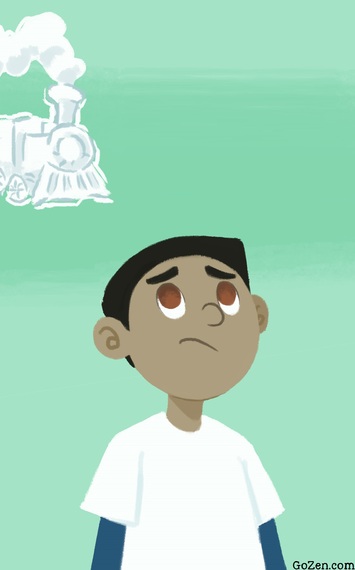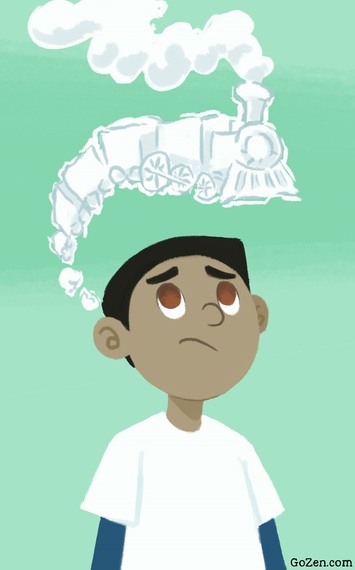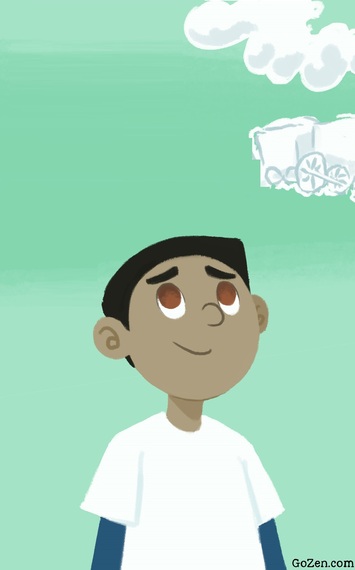Kids have anxious thoughts all the time...
"I'm going to fail math and never get into college."
"I'm totally screwing up this speech right now, and everyone knows it."
"What if I don't get asked to the dance? I'll be humiliated for life."
Research shows us that anxious thoughts are often blown out of proportion, skewed, or just plain wrong. Nonetheless, thoughts have power. Why? Because thoughts influence feelings and behaviors.
A simple thought passing through a child's mind can cause them to feel scared, worried, or sad; it can cause them to sulk, withdraw, or act out. Here's this point illustrated another way:
Thoughts → Feelings → Behavior
Example:
"No one likes me." → Sadness and embarrassment → Skipping school
Anxious thoughts can also become habitual and tip kids into a downward spiral of negativity.
So, what if we could teach our kids to take some of that power back? What if we could teach them to pick and choose which thoughts they "listen" or react to? We can. The first step in this process is to teach our kids to observe their thoughts by using a simple mindfulness exercise.
Why is mindfulness good?
In the late 1970s, developmental psychologist, John Flavell, gave a name to the idea that humans are aware of their own ability to think. Cognition about our own cognition (or thinking about thinking) was labeled metacognition.
As metacognitive beings, we have the capacity to disentangle ourselves from our own thinking with the use of mindfulness meditation. According to a pioneer in the field, Jon Kabat-Zinn, mindfulness is a mental practice of remaining present in the moment in a nonjudgmental way. At the heart of this practice is the idea that you are not your thoughts.
With this in mind, the goal for our children is to learn to observe their thoughts as something separate from themselves. In this, it's easier to see that thoughts are transient and we all have a choice as to whether to act upon our thoughts.
A substantial body of research shows that mindfulness practices have incredible benefits for children. Here's a small sample of findings:
- Research shows that teaching children mindfulness skills leads to greater well-being and less stress.
- Research shows that mindfulness improves children's ability to bounce back from challenges.
- Research shows that children enjoy learning mindfulness skills; in one study, 74 percent of kids said they would continue to practice mindfulness after their training was over.
Teaching kids to disentangle themselves from their own cognition seems a bit complex, but let's not underestimate our kids -- they are extraordinarily sophisticated and self-aware. It's our responsibility to tap into this self-awareness and leverage kids' love of creativity to make lessons relevant. In other words, let's use language that makes sense and make it fun!
Try this exercise:
1. Teach your child that thoughts are like trains that come and go through a busy station; we are simply standing on platform watching the trains go by. To practice, ask about a recent anxious thought your child had. Now, have your child visualize the train (thought) coming into the station.
2. Explain that when the train (thought) arrives, sometimes it just passes by and sometimes it stops for a while. When the train (thought) hangs out at the station for a while or remains in our mind, we can start to feel different emotions. It's OK to feel things; that's no problem. This is a good time to breathe in deeply and breathe out. Focus on the breath and not the train, because soon it is going to pass by.
3. Have your child "watch" as the train leaves. Explain that in time, just like the train, our thoughts move on and we stay behind.
Get more unique techniques to help relieve your child's anxiety at www.gozen.com.
Illustration credit: GoZen!
This post was originally published at PsychCentral as A Mindful Minute: How to Observe a Train of Anxious Thoughts.


